Abstract
Dideoxynucleosides such as 3'-azido-3'-deoxythymidine (AZT) and 2',3'-dideoxyinosine (ddI) can effectively inhibit the replication of human immunodeficiency virus (HIV) in T lymphoid cells. There is evidence that HIV can infect and replicate in other cells including monocytoid cells and macrophages. The present study compared the antiretroviral activities of ddI and AZT in three lineages of human cells, i.e., MOLT4 (T lymphocytoid, CD4+), U937 (monocytoid, CD4+), and HT1080 (fibroblastoid, CD4-) cells. Feline leukemia virus, a retrovirus that causes immunodeficiency in cats, was used to infect the cells. The drug concentrations needed to reduce the viral p27 antigen titers in cell lysates by 50% (IC50s) were determined. The data show that AZT and ddI inhibited viral replication in all three cell lines. The IC50s of AZT were 0.02, 1.75, and 2.31 microM in MOLT4, HT1080, and U937 cells, respectively. For ddI, the IC50s were 4.31, 9.52, and 43.5 microM, respectively. These data indicate differential antiviral activities of ddI and AZT in the different cells with the following rank order of drug sensitivity: MOLT4 > HT1080 > U937. A study of the intracellular metabolism of [3H]AZT and [3H]ddI shows that the antiretroviral activities of AZT and ddI in the three cell lines correlated with the levels of their intracellular triphosphate metabolites.
Full text
PDF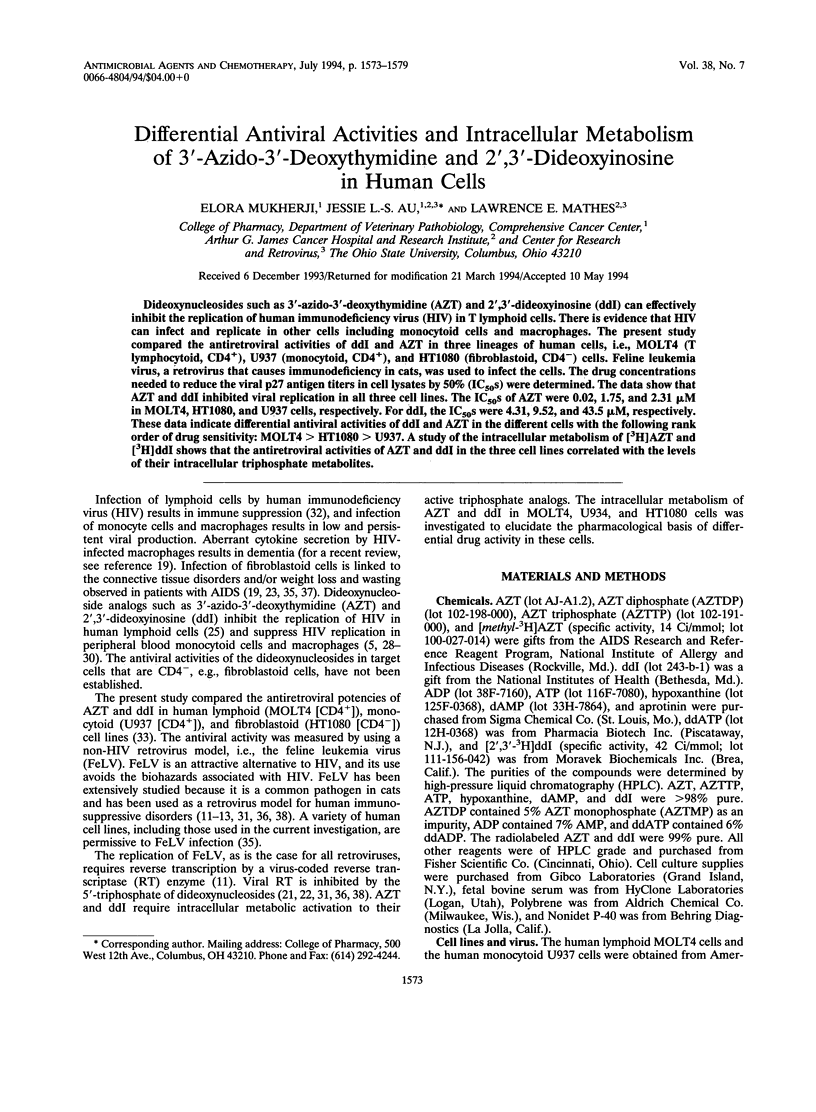
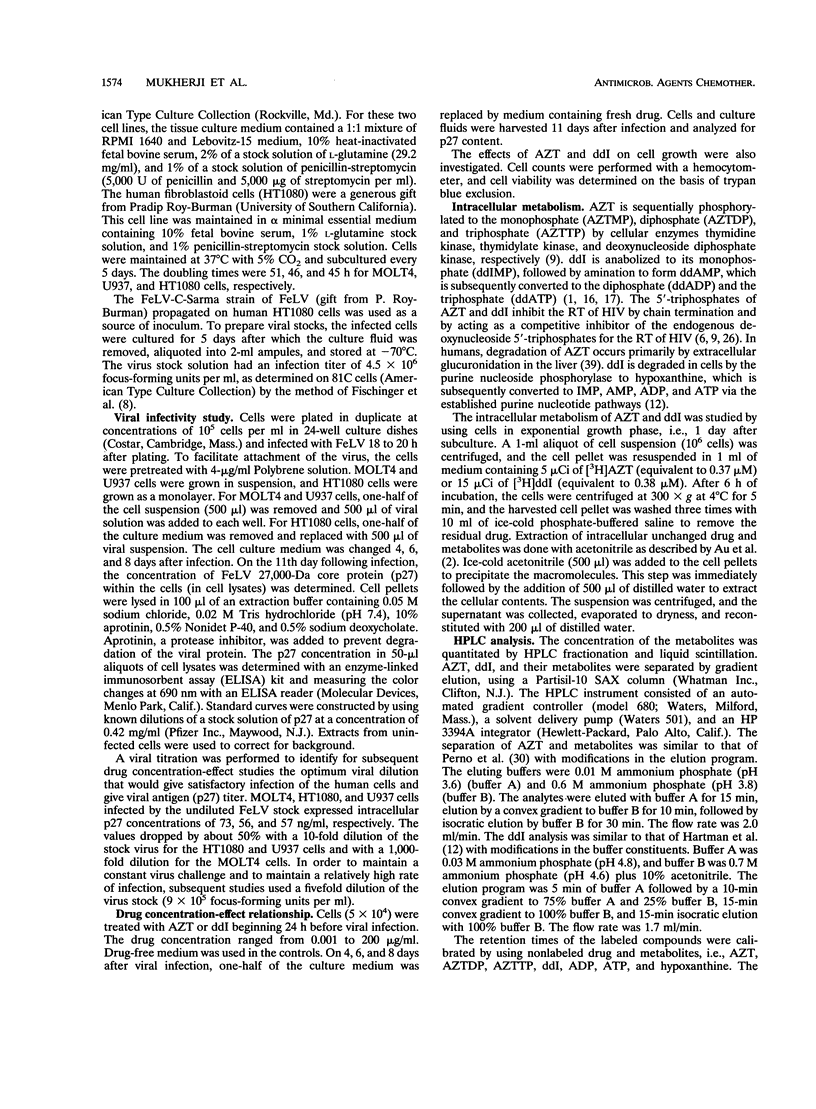
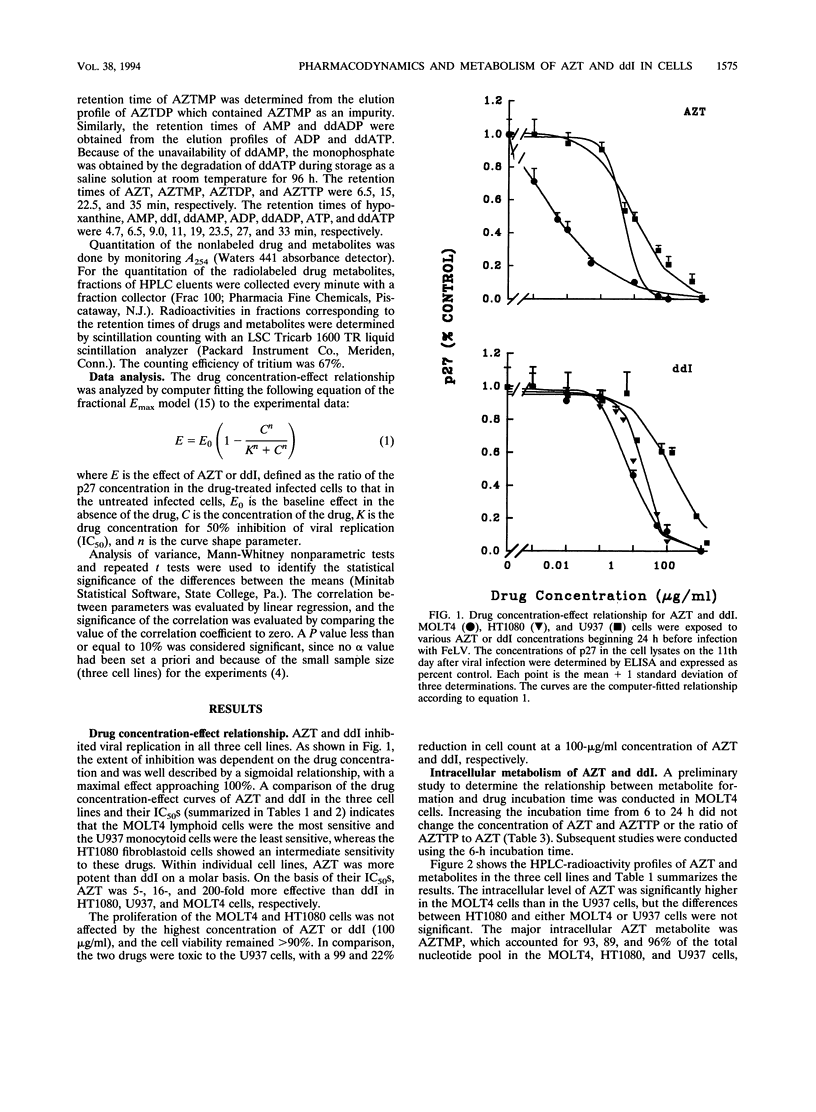


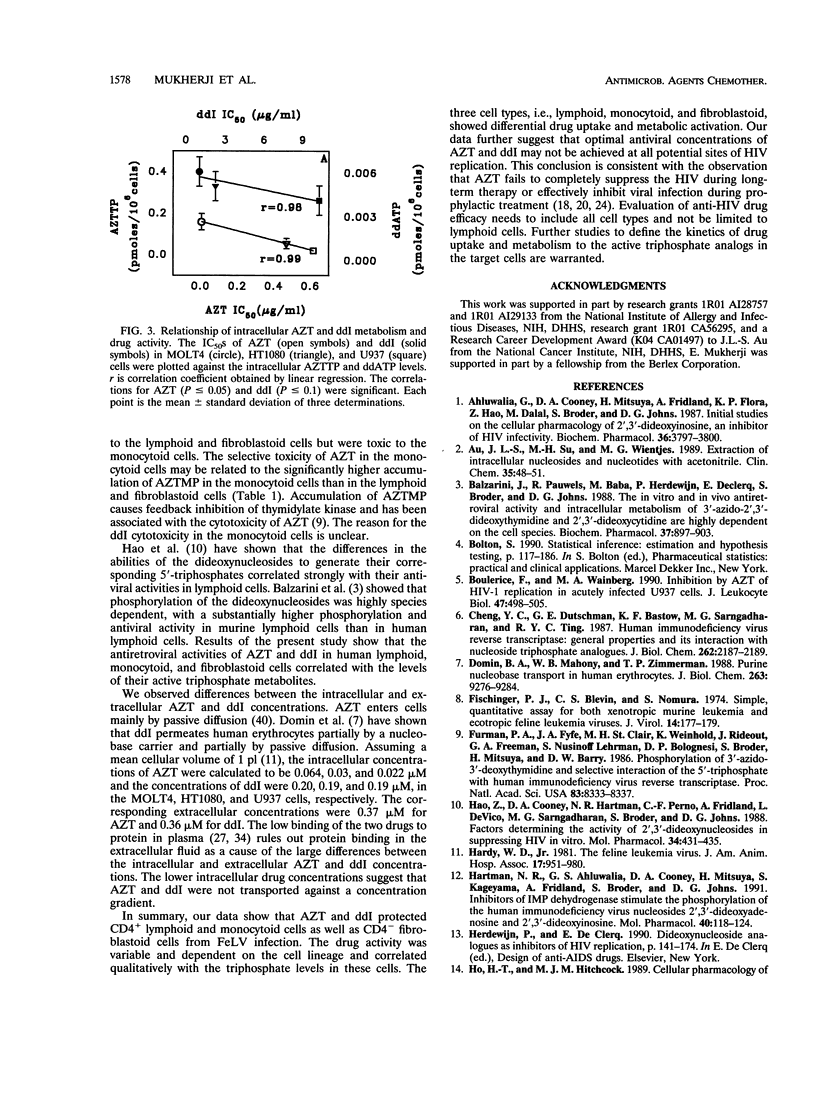
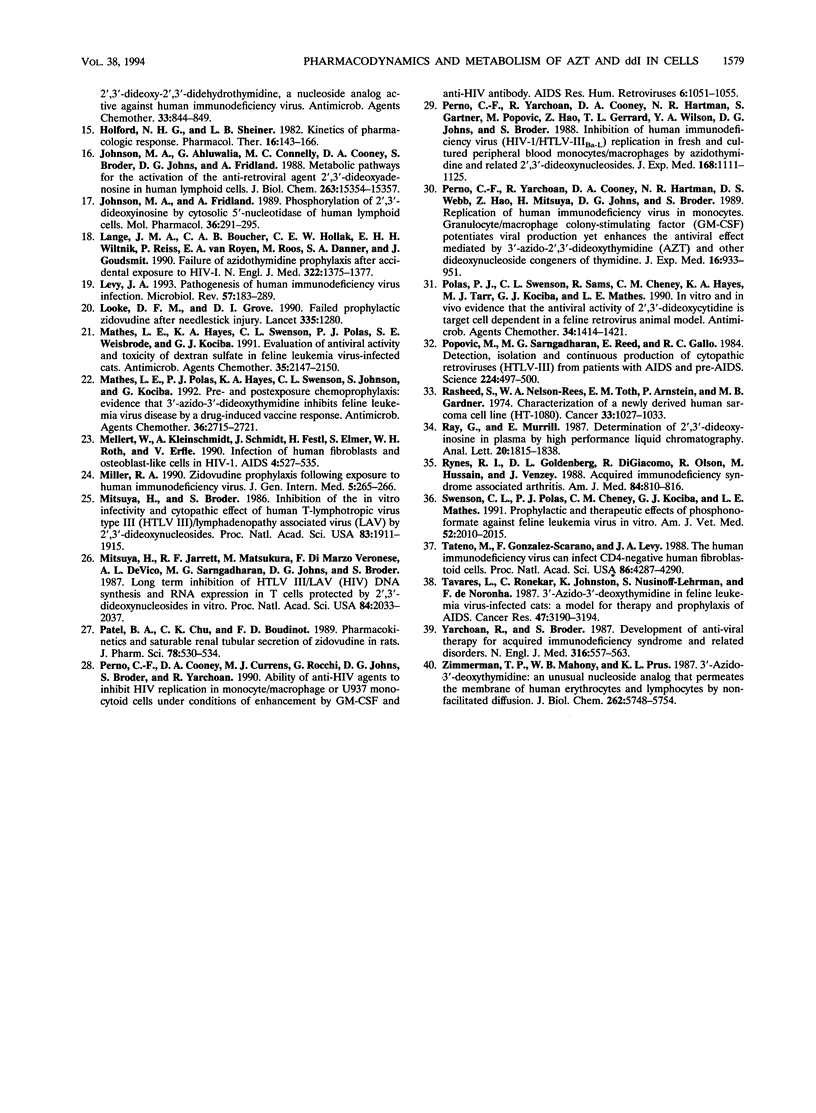
Selected References
These references are in PubMed. This may not be the complete list of references from this article.
- Ahluwalia G., Cooney D. A., Mitsuya H., Fridland A., Flora K. P., Hao Z., Dalal M., Broder S., Johns D. G. Initial studies on the cellular pharmacology of 2',3'-dideoxyinosine, an inhibitor of HIV infectivity. Biochem Pharmacol. 1987 Nov 15;36(22):3797–3800. doi: 10.1016/0006-2952(87)90440-0. [DOI] [PubMed] [Google Scholar]
- Au J. L., Su M. H., Wientjes M. G. Extraction of intracellular nucleosides and nucleotides with acetonitrile. Clin Chem. 1989 Jan;35(1):48–51. [PubMed] [Google Scholar]
- Balzarini J., Pauwels R., Baba M., Herdewijn P., de Clercq E., Broder S., Johns D. G. The in vitro and in vivo anti-retrovirus activity, and intracellular metabolism of 3'-azido-2',3'-dideoxythymidine and 2',3'-dideoxycytidine are highly dependent on the cell species. Biochem Pharmacol. 1988 Mar 1;37(5):897–903. doi: 10.1016/0006-2952(88)90178-5. [DOI] [PubMed] [Google Scholar]
- Boulerice F., Wainberg M. A. Inhibition by AZT of HIV-1 replication in acutely infected U-937 cells. J Leukoc Biol. 1990 Jun;47(6):498–505. doi: 10.1002/jlb.47.6.498. [DOI] [PubMed] [Google Scholar]
- Cheng Y. C., Dutschman G. E., Bastow K. F., Sarngadharan M. G., Ting R. Y. Human immunodeficiency virus reverse transcriptase. General properties and its interactions with nucleoside triphosphate analogs. J Biol Chem. 1987 Feb 15;262(5):2187–2189. [PubMed] [Google Scholar]
- Domin B. A., Mahony W. B., Zimmerman T. P. Purine nucleobase transport in human erythrocytes. Reinvestigation with a novel "inhibitor-stop" assay. J Biol Chem. 1988 Jul 5;263(19):9276–9284. [PubMed] [Google Scholar]
- Fischinger P. J., Blevins C. S., Nomura S. Simple, quantitative assay for both xenotropic murine leukemia and ecotropic feline leukemia viruses. J Virol. 1974 Jul;14(1):177–179. doi: 10.1128/jvi.14.1.177-179.1974. [DOI] [PMC free article] [PubMed] [Google Scholar]
- Furman P. A., Fyfe J. A., St Clair M. H., Weinhold K., Rideout J. L., Freeman G. A., Lehrman S. N., Bolognesi D. P., Broder S., Mitsuya H. Phosphorylation of 3'-azido-3'-deoxythymidine and selective interaction of the 5'-triphosphate with human immunodeficiency virus reverse transcriptase. Proc Natl Acad Sci U S A. 1986 Nov;83(21):8333–8337. doi: 10.1073/pnas.83.21.8333. [DOI] [PMC free article] [PubMed] [Google Scholar]
- Hao Z., Cooney D. A., Hartman N. R., Perno C. F., Fridland A., DeVico A. L., Sarngadharan M. G., Broder S., Johns D. G. Factors determining the activity of 2',3'-dideoxynucleosides in suppressing human immunodeficiency virus in vitro. Mol Pharmacol. 1988 Oct;34(4):431–435. [PubMed] [Google Scholar]
- Hartman N. R., Ahluwalia G. S., Cooney D. A., Mitsuya H., Kageyama S., Fridland A., Broder S., Johns D. G. Inhibitors of IMP dehydrogenase stimulate the phosphorylation of the anti-human immunodeficiency virus nucleosides 2',3'-dideoxyadenosine and 2',3'-dideoxyinosine. Mol Pharmacol. 1991 Jul;40(1):118–124. [PubMed] [Google Scholar]
- Holford N. H., Sheiner L. B. Kinetics of pharmacologic response. Pharmacol Ther. 1982;16(2):143–166. doi: 10.1016/0163-7258(82)90051-1. [DOI] [PubMed] [Google Scholar]
- Johnson M. A., Ahluwalia G., Connelly M. C., Cooney D. A., Broder S., Johns D. G., Fridland A. Metabolic pathways for the activation of the antiretroviral agent 2',3'-dideoxyadenosine in human lymphoid cells. J Biol Chem. 1988 Oct 25;263(30):15354–15357. [PubMed] [Google Scholar]
- Johnson M. A., Fridland A. Phosphorylation of 2',3'-dideoxyinosine by cytosolic 5'-nucleotidase of human lymphoid cells. Mol Pharmacol. 1989 Aug;36(2):291–295. [PubMed] [Google Scholar]
- Lange J. M., Boucher C. A., Hollak C. E., Wiltink E. H., Reiss P., van Royen E. A., Roos M., Danner S. A., Goudsmit J. Failure of zidovudine prophylaxis after accidental exposure to HIV-1. N Engl J Med. 1990 May 10;322(19):1375–1377. doi: 10.1056/NEJM199005103221907. [DOI] [PubMed] [Google Scholar]
- Levy J. A. Pathogenesis of human immunodeficiency virus infection. Microbiol Rev. 1993 Mar;57(1):183–289. doi: 10.1128/mr.57.1.183-289.1993. [DOI] [PMC free article] [PubMed] [Google Scholar]
- Looke D. F., Grove D. I. Failed prophylactic zidovudine after needlestick injury. Lancet. 1990 May 26;335(8700):1280–1280. doi: 10.1016/0140-6736(90)91343-9. [DOI] [PubMed] [Google Scholar]
- Mathes L. E., Hayes K. A., Swenson C. L., Polas P. J., Weisbrode S. E., Kociba G. J. Evaluation of antiviral activity and toxicity of dextran sulfate in feline leukemia virus-infected cats. Antimicrob Agents Chemother. 1991 Oct;35(10):2147–2150. doi: 10.1128/aac.35.10.2147. [DOI] [PMC free article] [PubMed] [Google Scholar]
- Mathes L. E., Polas P. J., Hayes K. A., Swenson C. L., Johnson S., Kociba G. J. Pre- and postexposure chemoprophylaxis: evidence that 3'-azido-3'-dideoxythymidine inhibits feline leukemia virus disease by a drug-induced vaccine response. Antimicrob Agents Chemother. 1992 Dec;36(12):2715–2721. doi: 10.1128/aac.36.12.2715. [DOI] [PMC free article] [PubMed] [Google Scholar]
- Mellert W., Kleinschmidt A., Schmidt J., Festl H., Emler S., Roth W. K., Erfle V. Infection of human fibroblasts and osteoblast-like cells with HIV-1. AIDS. 1990 Jun;4(6):527–535. doi: 10.1097/00002030-199006000-00006. [DOI] [PubMed] [Google Scholar]
- Miller R. A. Zidovudine prophylaxis following exposure to human immunodeficiency virus. J Gen Intern Med. 1990 May-Jun;5(3):265–267. doi: 10.1007/BF02600547. [DOI] [PubMed] [Google Scholar]
- Mitsuya H., Broder S. Inhibition of the in vitro infectivity and cytopathic effect of human T-lymphotrophic virus type III/lymphadenopathy-associated virus (HTLV-III/LAV) by 2',3'-dideoxynucleosides. Proc Natl Acad Sci U S A. 1986 Mar;83(6):1911–1915. doi: 10.1073/pnas.83.6.1911. [DOI] [PMC free article] [PubMed] [Google Scholar]
- Mitsuya H., Jarrett R. F., Matsukura M., Di Marzo Veronese F., DeVico A. L., Sarngadharan M. G., Johns D. G., Reitz M. S., Broder S. Long-term inhibition of human T-lymphotropic virus type III/lymphadenopathy-associated virus (human immunodeficiency virus) DNA synthesis and RNA expression in T cells protected by 2',3'-dideoxynucleosides in vitro. Proc Natl Acad Sci U S A. 1987 Apr;84(7):2033–2037. doi: 10.1073/pnas.84.7.2033. [DOI] [PMC free article] [PubMed] [Google Scholar]
- Patel B. A., Chu C. K., Boudinot F. D. Pharmacokinetics and saturable renal tubular secretion of zidovudine in rats. J Pharm Sci. 1989 Jul;78(7):530–534. doi: 10.1002/jps.2600780704. [DOI] [PubMed] [Google Scholar]
- Perno C. F., Cooney D. A., Currens M. J., Rocchi G., Johns D. G., Broder S., Yarchoan R. Ability of anti-HIV agents to inhibit HIV replication in monocyte/macrophages or U937 monocytoid cells under conditions of enhancement by GM-CSF or anti-HIV antibody. AIDS Res Hum Retroviruses. 1990 Aug;6(8):1051–1055. doi: 10.1089/aid.1990.6.1051. [DOI] [PubMed] [Google Scholar]
- Perno C. F., Yarchoan R., Cooney D. A., Hartman N. R., Gartner S., Popovic M., Hao Z., Gerrard T. L., Wilson Y. A., Johns D. G. Inhibition of human immunodeficiency virus (HIV-1/HTLV-IIIBa-L) replication in fresh and cultured human peripheral blood monocytes/macrophages by azidothymidine and related 2',3'-dideoxynucleosides. J Exp Med. 1988 Sep 1;168(3):1111–1125. doi: 10.1084/jem.168.3.1111. [DOI] [PMC free article] [PubMed] [Google Scholar]
- Perno C. F., Yarchoan R., Cooney D. A., Hartman N. R., Webb D. S., Hao Z., Mitsuya H., Johns D. G., Broder S. Replication of human immunodeficiency virus in monocytes. Granulocyte/macrophage colony-stimulating factor (GM-CSF) potentiates viral production yet enhances the antiviral effect mediated by 3'-azido-2'3'-dideoxythymidine (AZT) and other dideoxynucleoside congeners of thymidine. J Exp Med. 1989 Mar 1;169(3):933–951. doi: 10.1084/jem.169.3.933. [DOI] [PMC free article] [PubMed] [Google Scholar]
- Polas P. J., Swenson C. L., Sams R., Cheney C. M., Hayes K. A., Tarr M. J., Kociba G. J., Mathes L. E. In vitro and in vivo evidence that the antiviral activity of 2',3'-dideoxycytidine is target cell dependent in a feline retrovirus animal model. Antimicrob Agents Chemother. 1990 Jul;34(7):1414–1421. doi: 10.1128/aac.34.7.1414. [DOI] [PMC free article] [PubMed] [Google Scholar]
- Popovic M., Sarngadharan M. G., Read E., Gallo R. C. Detection, isolation, and continuous production of cytopathic retroviruses (HTLV-III) from patients with AIDS and pre-AIDS. Science. 1984 May 4;224(4648):497–500. doi: 10.1126/science.6200935. [DOI] [PubMed] [Google Scholar]
- Rasheed S., Nelson-Rees W. A., Toth E. M., Arnstein P., Gardner M. B. Characterization of a newly derived human sarcoma cell line (HT-1080). Cancer. 1974 Apr;33(4):1027–1033. doi: 10.1002/1097-0142(197404)33:4<1027::aid-cncr2820330419>3.0.co;2-z. [DOI] [PubMed] [Google Scholar]
- Rynes R. I., Goldenberg D. L., DiGiacomo R., Olson R., Hussain M., Veazey J. Acquired immunodeficiency syndrome-associated arthritis. Am J Med. 1988 May;84(5):810–816. doi: 10.1016/0002-9343(88)90057-5. [DOI] [PubMed] [Google Scholar]
- Swenson C. L., Polas P. J., Cheney C. M., Kociba G. J., Mathes L. E. Prophylactic and therapeutic effects of phosphonoformate against feline leukemia virus in vitro. Am J Vet Res. 1991 Dec;52(12):2010–2015. [PubMed] [Google Scholar]
- Tateno M., Gonzalez-Scarano F., Levy J. A. Human immunodeficiency virus can infect CD4-negative human fibroblastoid cells. Proc Natl Acad Sci U S A. 1989 Jun;86(11):4287–4290. doi: 10.1073/pnas.86.11.4287. [DOI] [PMC free article] [PubMed] [Google Scholar]
- Tavares L., Roneker C., Johnston K., Lehrman S. N., de Noronha F. 3'-Azido-3'-deoxythymidine in feline leukemia virus-infected cats: a model for therapy and prophylaxis of AIDS. Cancer Res. 1987 Jun 15;47(12):3190–3194. [PubMed] [Google Scholar]
- Yarchoan R., Broder S. Development of antiretroviral therapy for the acquired immunodeficiency syndrome and related disorders. A progress report. N Engl J Med. 1987 Feb 26;316(9):557–564. doi: 10.1056/NEJM198702263160925. [DOI] [PubMed] [Google Scholar]
- Zimmerman T. P., Mahony W. B., Prus K. L. 3'-azido-3'-deoxythymidine. An unusual nucleoside analogue that permeates the membrane of human erythrocytes and lymphocytes by nonfacilitated diffusion. J Biol Chem. 1987 Apr 25;262(12):5748–5754. [PubMed] [Google Scholar]


